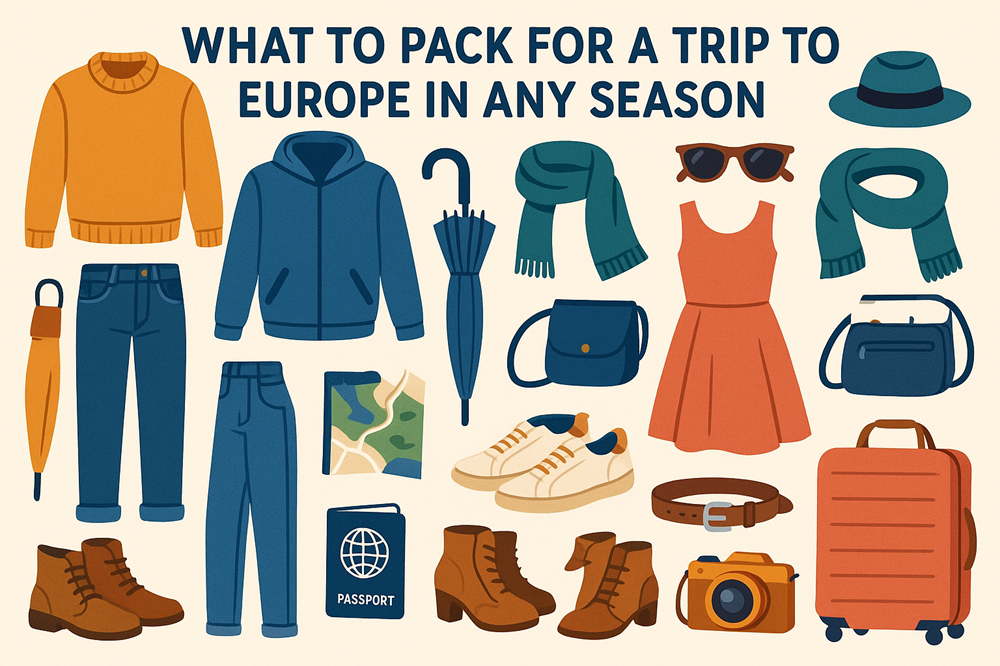What to Pack for a Trip to Europe in Any Season

Planning a trip to Europe is exciting, but one of the biggest questions travelers face is: what should I pack? Europe’s weather can vary drastically depending on the country and season, so packing smart is key to staying comfortable, stylish, and prepared. From clothing to tech gadgets, this guide will help you pack efficiently for any season, without forgetting the essentials - like staying connected with an eSIM service.
1. Clothing Essentials
a) Layering is Key
Europe’s weather can change quickly, even within the same day. Packing layers helps you adapt. Include:
-
Lightweight t-shirts or tops
-
Long-sleeve shirts
-
Sweaters or cardigans
-
A warm jacket for colder months
-
A rain jacket or waterproof shell
b) Season-Specific Tips
-
Spring: Pack a light jacket and umbrella; flowers are blooming, but it can be chilly.
-
Summer: Bring breathable clothing, sun hats, and sunglasses; European summers can get hot, especially in Southern Europe.
-
Autumn: Warm layers and scarves are helpful; early sunsets mean cooler evenings.
-
Winter: Heavy coat, gloves, hats, and thermal underlayers are essential for Northern and Central Europe.
2. Footwear
Comfortable shoes are a must because you’ll likely walk a lot. Consider:
-
A pair of sturdy walking shoes for city tours
-
Sandals or breathable shoes for summer
-
Waterproof boots for rainy or snowy conditions
Tip: Get new shoes comfortable by wearing them ahead of your journey.
3. Travel Accessories
-
Travel-sized toiletries: Pack efficiently while following airline guidelines.
-
Packing cubes: Keep your luggage organized.
-
Reusable water bottle: Stay hydrated and eco-friendly.
-
Travel adapter: Europe uses different plug types (Type C, E, F).
4. Tech Essentials
-
Phone and charger: Essential for navigation and communication.
-
Portable power bank: Keeps devices charged during long sightseeing days.
-
Camera or smartphone with a good camera: Capture memories.
-
eSIM service: Instead of swapping SIM cards in each country, an eSIM service allows you to stay connected across multiple European countries easily. You can access maps, book tickets, and call or message without worrying about roaming fees.
5. Documents and Money
-
Passport and photocopies
-
Travel insurance details
-
Credit/debit cards and some cash in local currency
-
Travel itinerary and tickets (digital copies on your phone are convenient)
6. Health and Safety Essentials
-
Basic first-aid kit: Band-aids, pain relievers, any personal medication
-
Hand sanitizer and masks (if preferred)
-
Sunscreen, especially in summer
7. Tips for Packing Light
-
Mix and match: Pack clothing that can be combined in different ways.
-
Roll, don’t fold: Saves space and reduces wrinkles.
-
Limit shoes: Shoes take up the most space - stick to 2–3 versatile pairs.
-
Laundry options: Many accommodations have laundry facilities, so you can reuse clothes.
8. Special Items for Different Activities
-
Hiking gear for trips to the Alps or Pyrenees
-
Swimwear for Mediterranean beaches
-
Evening wear for cultural events, restaurants, or theaters
9. Carry-On Essentials
Even if you check a bag, pack essentials in your carry-on:
-
Change of clothes
-
Travel documents
-
Medications
-
Snacks
-
Electronics and chargers
This ensures you’re prepared if luggage is delayed.
FAQs About Packing for Europe
Q1: How much clothing should I pack for a two-week Europe trip?
A: Aim for 7–10 tops, 3–5 bottoms, 2-3 pairs of shoes, and 1-2 jackets. Use layering to adapt to temperature changes.
Q2: Do I need a heavy winter coat for Europe in winter?
A: For Northern and Central Europe, yes. Southern Europe (like Spain or Italy) can be milder, so a medium jacket may suffice.
Q3: Can I use my phone in multiple European countries without changing SIM cards?
A: Yes! Using an eSIM service lets you stay connected in multiple countries without buying separate SIM cards or paying roaming fees.
Q4: Are packing cubes worth it for Europe travel?
A: Absolutely. They help organize clothes, save space, and make packing/unpacking quicker.
Q5: Should I carry cash or rely on cards in Europe?
A: Both. Most places accept cards, but having some local currency for markets, taxis, or small purchases is recommended.
Q6: How can I avoid overpacking?
A: Stick to versatile clothing, pack for layers, and limit shoes. Plan to do laundry if traveling long-term.
Final Tips
Packing smart means you can enjoy Europe comfortably in any season without lugging around heavy bags. Review the weather forecast ahead of your trip and tailor your packing list to match the conditions. Don’t forget essentials like your phone, charger, and an eSIM service to stay connected for maps, bookings, and travel tips.
By planning carefully and packing strategically, you can focus on experiencing Europe’s culture, food, and history - without the stress of overpacking or forgetting important items.
- AI
- Vitamins
- Health
- Admin/office jobs
- News
- Art
- Causes
- Crafts
- Dance
- Drinks
- Film
- Fitness
- Food
- Jogos
- Gardening
- Health
- Início
- Literature
- Music
- Networking
- Outro
- Party
- Religion
- Shopping
- Sports
- Theater
- Wellness


